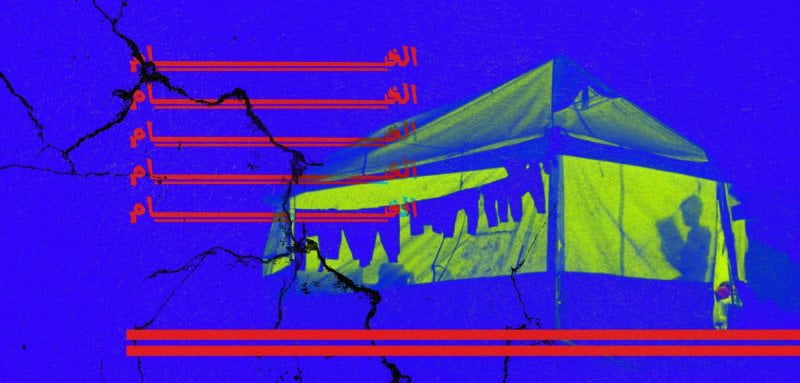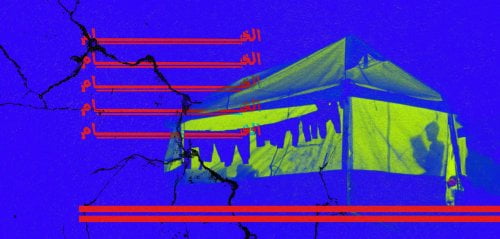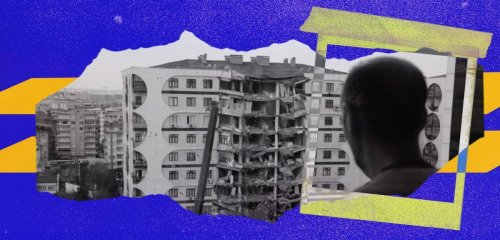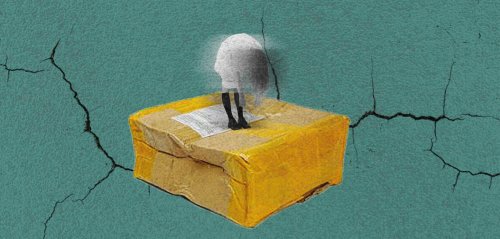In a struggle between life and death, doctor Mohammad al-Khalaf, a resident of the village of Besnaya in rural Harem, northwest of Idlib, rushes with his family of ten, to flee from his two-story house out into the open for fear that the building will collapse on top of their heads. The dawn of Monday, February 6, was not a normal dawn for Syrians. It was a brand new experience compared to everything they had gone through during their long years of war and crisis.
Mohammad, who works as a pediatrician at a primary health care center in Idlib, says, “We managed to escape from the outlying buildings in the village of Besnaya, only to be met with a scene that made us fall into a panic greater and more severe than the earthquake itself, as we did not find a village in front of us. The entire village was leveled to the ground, where do we turn? Where do we seek refuge? I quickly took my family to a camp for our relatives that they had built years ago near the residential buildings.”
“We managed to escape from the outlying buildings in the village, only to be met with a scene that made us fall into a panic greater and more severe than the earthquake itself, as we did not find a village in front of us. The entire village was leveled to the ground. Where do we seek refuge?"
According to Fawaz al-Abed, who lives near the village, Besnaya is something akin to a residential complex near the city of Harem, containing around 150 families. It has a bakery and shops, and is inhabited by people who left their tents and bought apartments there, most of whom migrated from the countryside of Aleppo. He says, "It was as if the apartment complex was wiped off the map by the earthquake. There was not a single house left that did not fall on the heads of its occupants.”
He, too, had fled the earthquake and from a building that almost fell on him, his family, and everyone living in it, and found nowhere else to go except the camp where his relatives live, next to the village as well, or what had previously been a village, after it was turned into a pile of rubble and a mass grave. "We sought refuge with relatives. We went back to the same tents we had lived in at the beginning of our exile-displacement," he says.
Families in northern Syria began a reverse escape after the earthquake and found no safe refuge in front of them other than the camps scattered in the area
In another scene in the city of Al-Dana, north of Idlib, Firas Talji, left his second-floor home in a four-story building, with his family, after being told that the house had to be evacuated due to the fear that the building would collapse from the earthquake. He found no refuge except for his relatives who live in Qinnasrin camp, near the Atmeh area, a camp that has not been affected by all the destruction that happened on early Monday morning.
Camps open their arms
In northern Syria today, the situation has become reversed in a strange and depressing paradox, as is the case of the people here; tents have become safer than houses built of stone and cement. Following the years of oppression that the camp residents lived under due to weather fluctuations of heat and cold, worn-out tents, humanitarian needs, and rough roads, today, this tent is the only safe refuge from the earthquake that destroyed entire neighborhoods on the heads of its inhabitants.
“It was as if the village was wiped off the map by the earthquake. There was not a single house left that did not fall on the heads of its occupants”
The camp managers of the areas of Idlib and northern Aleppo, who have a group on WhatsApp for humanitarian coordination, are racing to offer assistance and welcome those who have been affected (the residents of concrete houses) from the earthquake that struck northern Syria and Turkey and affected most of the neighboring countries. Some camps prepared special tents for them, and others shared their food and accommodation.
Khaled al-Omar, director of al-Rahmeen camp in the Harbnoush area north of Idlib, says, "We offered to receive those affected by the earthquake that struck the Harem area and its surroundings, so on Tuesday, we welcomed seven families from the Harem region, whose homes were destroyed and they barely got out with what they could carry in their belongings, so we gave some of them tents and shared the rest our tents and places of residence."
He adds, "Their situation was tragic. They were in the rain in the street, the temperatures were very low, and they had found no shelter for them except our humble camp, whose residents rushed to collect some sponges, blankets, food, and means of heating to help them as much as possible, although our camp, which has a population of 87 families, suffers from a great shortage in needs, but this is our duty towards our afflicted people."
For his part, the director of Al-Souss camp in the Sheikh Bahr area, northwest of Idlib, Hatem Matar, spoke about letting in families who came from Afrin and shared housing with the camp residents in their tents, saying, "Our camp is inhabited by 90 families, half of whom do not receive aid, and despite the urgent need and the presence of orphans and the disabled, but we chose not to stand idly by in the face of the tragedy of the earthquake, especially since we have had a week of severe cold and lack of services in the camp, but it remains better than being out in the open and living in cracked buildings that are in danger of collapsing at any moment."
Rifaat al-Asri, director of Abu Habba camp in the Kafr Hamoul area north of Idlib, also welcomed several families from the town of Zardana, who came from the countryside of Idlib, who left their flattened homes and fled for fear of death.
Besnaya is a residential complex near the city of Harem, inhabited by people who left their tents and bought apartments there. It was flattened as a result of the earthquake, and those who survived it, returned to the tents
"I keep my tent"
Ali al-Murr, a displaced person from the village of Umm Jalal, southeast of Idlib, lives in the city of Binnish, east of Idlib. He kept his tent that he received when he used to live in a camp, and then moved to a house, to install it in agricultural land and live with his family until the earthquake subsided, while the director of al-Nuaimia camp, Ammar Al-Hajij, offered some of his friends fleeing the horror of the earthquake some of his extra tents to build and house them in.
A humanitarian tragedy swept the northwestern region of Syria, amid panic that hit the residents of northern Syria as a result of the continued aftershocks and the continued collapse of cracked houses. According to Mohammed al-Ahmad, director of al-Zaytoun camp in the Kalli area north of Idlib, the tragedy befell everyone, and those who did not die from the earthquake are living in pain and anguish over what befell their families, relatives and neighbors.
He says, "We welcomed the people even though we ourselves are in need, we shared them our tents and bread, despite the hard situation and the scarcity of resources,” appealing to the United Nations, international organizations and Arab countries for urgent assistance to the Syrians in the north, while Turkey is busy rescuing the victims of the earthquake. He adds that "the civil defense and volunteer teams are working with all their capacity, but the disaster is bigger than everyone, and we stand helpless most of the time as we try to remove the rubble, and cannot get people out from under even as we hear their voices and calls for help."
A number of volunteer teams and humanitarian organizations in northern Syria worked on equipping shelter centers, which were distributed in the areas of Idlib and the Aleppo countryside
Need and solidarity
A number of volunteer teams and humanitarian organizations in northern Syria worked to equip the shelter centers, which were distributed in Idlib camp, Sheikh Bahar camp, Maarat Misrin camp, Koknaya camp, Watan camp, Kamouna camp, and Kelly camp. Whereas the following camps received a number of people fleeing the earthquake: Mahmoudiya Center, Service Garage Camp, Al-Bustan Camp, Hope Gathering Camp, Tel Rajo Entrance Camp, Al-Birin Factory Camp, Mamli Camp, Tal Al-Taweel Camp, Salah Al-Din Rajo Camp, Sheikh Al-Deir Camp, Sala Camp Jane, Khalidiya Camp, Prison Camp, Zahra Camp, Ihsan Camp, Jisr Afrin Camp, Qatma 1 Camp, Khirbet Alloush Camp, Sindianka Camp, Shatt Camp, Jdeideh Camp, Rahmat Tel Salour Camp, Soliman Lounge Camp, and Barmaya Camp.
The residents of the camps in northern Syria suffer from a severe shortage of needs, and a scarcity of resources, amid the deterioration of economic conditions in an area that depends mainly on UN aid. There are about 1,400 camps, in which 1.8 million displaced people live, and rainy weather and low temperatures have further worsened the tragedy, causing great damage in the camps, which need recovery projects, especially to address the damages and non-isolated roads, and are also in urgent need of heating equipment and materials. The camps are also witnessing a significant deficit in terms of humanitarian response, especially in the food, heating, and water sectors, according to the Humanitarian Response Coordinators Team in Syria.
Civil defense teams, volunteer teams and all equipment of the military opposition factions continue to remove rubble from the missing under the rubble after the earthquake, amid a shortage of equipment and the lack of international aid to northern Syria, despite their arrival and the start of their work in the affected centers in Turkey.
The death toll following deadly earthquakes in Turkey and Syria has surpassed 25,000. According to the Syrian Civil Defense, the death toll from the earthquake in northwestern Syria alone has risen to more than 3,553 deaths and more than 5,273 injured, and the number is likely to rise significantly due to the presence of hundreds of families under the rubble as search and rescue operations continue, and the number of completely collapsed buildings has increased to more than 375 buildings, partially collapsed buildings to more than 1,200 buildings, and thousands of other buildings have cracked.
Raseef22 is a not for profit entity. Our focus is on quality journalism. Every contribution to the NasRaseef membership goes directly towards journalism production. We stand independent, not accepting corporate sponsorships, sponsored content or political funding.
Support our mission to keep Raseef22 available to all readers by clicking here!
Interested in writing with us? Check our pitch process here!










Join the Conversation
Ghina Hashem -
8 hours agoالحب حرام بس اعلامهم يلي ماجابت للبلد الا الدمار معليش يرفعوها نحنى محاربون في الشرق الاوسط كافة
ذوالفقار عباس -
1 day agoا
Hossam Sami -
1 day agoصعود "أحزاب اليمين" نتيجة طبيعية جداً لرفض البعض; وعددهم ليس بالقليل أبداً. لفكرة الإندماج بل...
Anonymous user -
3 days agoرائع و عظيم ..
جيسيكا ملو فالنتاين -
1 week agoزاوية الموضوع لطيفة وتستحق التفكير إلا أنك حجبت عن المرأة أدوارا مهمة تلعبها في العائلة والمجتمع...
Bosaina Sharba -
1 week agoحلو الAudio
شكرا لالكن